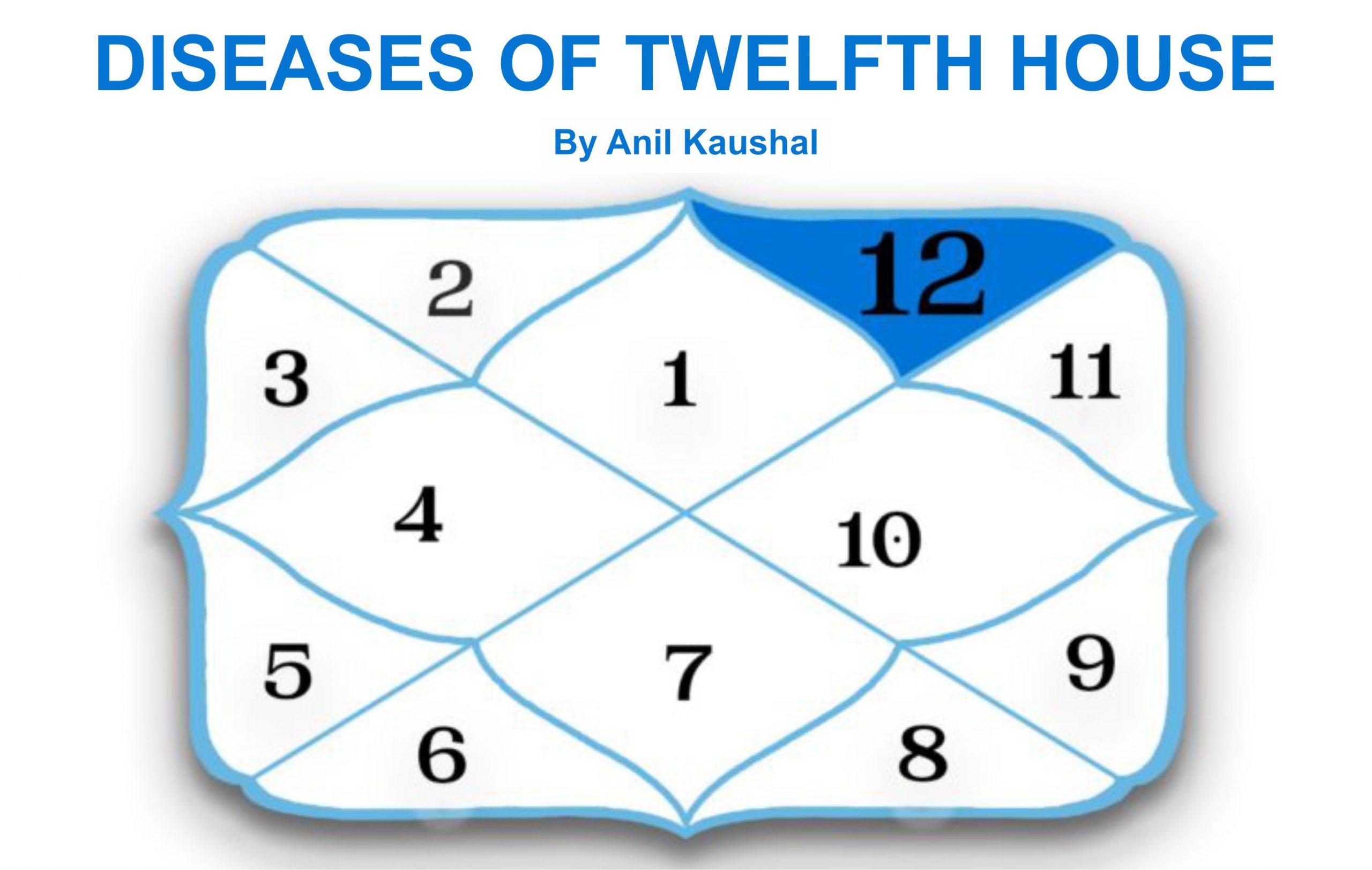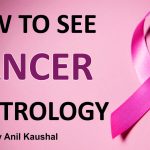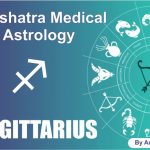
Diseases of Twelfth House
1. Introduction
1.1 The twelfth is the last house of a horoscope when counted from ascendant. Therefore it marks the end or expense of the cycle or the wheel of life. Since lagna represents the life, health, wealth, physical body and vitality etc, the 12 th house represents the destruction or expenditure of these traits. Therefore some astrologers consider it as an alternate house of death along with 8 th house. The association of 12 th house with any house or house lord destroys that house. But any planet when posited in this house unafflicted, it flourishes the Jeeva indication of that house but not the other significations it represents.
Along with 2 nd , this house is considered to be impressions neutral\ and gives results as per the other sign of its lord or planets placed in/ aspecting it.
1.2 As per Phal Deepika, it is known as Leena Sthan (hidden house) and represents sub-conscious mind, sorrows, miseries losses, mental worries, confinement, imprisonment, asylums, loss of children/ spouse, sleep, dreams and fantasies etc. In natural zodiac, this house is represented by watery & mystic Pisces with Jupiter as its lord. It represents feet, left eye and lymphatic system. But Saturn is the primary Karaka of this house, with Mars controlling confinement & accident, Rahu diseases of feet & jail and Jupiter deep knowledge & hope. 12th house represents diseases in the feet, left eye, insomnia, imprisonment/ isolation (being 7th from 6th house), criminals anti-social elements, kidnapping, rape (being 8th from 5th and 5th from 8th house)etc.
2. Diseases of foot
2.1 Diseases of the foot generally are not limited, as they are related to or manifest elsewhere in the body. However, the foot is often the first place some of these diseases or a sign or symptom of others appears.
This is because of the foot distance from the central circulation, the heart and its constant exposure to pressures from the ground and the weight of the body. The foot may look simple but is a complex structure with 26 bones, 33 joints, numerous muscles, nerves and different ligament types. Any part of the foot can be affected. Some foot disorders may present with just a mild ache, but other foot disorders can be very serious and limit ability to walk or bear weight. Most minor cases of foot pain respond to home care treatments except when severe pain is present as it is a disabling condition and usually needs medical attention. Some of the common diseases of foot are given in next sub-Para.
2.2 Fungal/ Bacterial Conditions including athlete foot:
i) Fungal/ Bacterial Conditions including athlete foot, occur because our feet spend a lot of time in shoes- a warm, dark, humid place that is perfect for fungus to grow. Fungal and bacterial conditions can
cause dry skin, redness, and blisters, itching, and peeling. If not treated right away, an infection may be hard to cure. To prevent infections, keep your feet- especially the area between your toes-clean and dry.
ii) Corns, Warts or Spurs are caused by friction and pressure when the bony parts of your feet rub against your shoes. Sometimes wearing shoes that fit better or using special pads solves the problem. A wart is a localized over-growth of skin layer caused by a virus. Spurs are calcium growths that develop on bones of the feet. They are caused by muscle strain in the feet standing for long periods of time, wearing
badly fitting shoes, or being overweight can make spurs worse. Treating them yourself may be harmful, especially if you have diabetes or poor circulation.
iii) Bunions develop when the joints in the big toe no longer fit together as they should and becomes swollen and tender. Bunions tend to run in families. If a bunion is not severe, wearing shoes cut wide at the instep and toes, taping the foot, or wearing pads that cushion the bunion may help the pain. Other treatments include physical therapy and wearing orthotic devices or shoe inserts. Sometimes anti-
inflammatory drug and cortisone injection or surgery is needed to relieve the pressure & pain and repair the toe joint.
iv) Ingrown toe-nails occur when a piece of the nail breaks the skin- which can happen if you don't cut your nails properly. Ingrown toenails are very common in the large toes. In grown toenails can
often be avoided by cutting the toenail straight across and level with the top of the toe.
v) Hammertoe is caused by a shortening of the tendons that control toe movements. The toe knuckle is usually enlarged, drawing the toe back. Over time, the joint enlarges and stiffens as it rubs against
shoes. Your balance may be affected. Wearing shoes and stockings with plenty of toe room is a treatment for hammertoe. In very serious cases, surgery may be needed.
vi) Diabetic Foot: Not all people with diabetes develop foot problems. But people with diabetes are more prone to infection. They can also develop neuropathy (damaged nerves) peripheral vascular disease
(blocked arteries) of the legs and either can lead to foot ulceration. Infection and foot ulceration, alone or in combination, often lead to amputation. Neuropathy and peripheral vascular disease can also
cause distressing pain in the lower limbs. Many people with diabetes are at risk of developing foot problems. For people already with infection or ulceration, the important thing is to urgently treat the
infection and heal the ulcer. For people with pain, the important thing is to determine whether it is due to neuropathy or vascular disease because the treatment for them is quite different.
vii) Frost bite: It is the medical condition where localized damage is caused to skin and other tissues due to freezing. Frostbite is most likely to happen in body parts farthest from the heart and those with large exposed areas. Inadequate blood circulation when the ambient temperature is below freezing leads to frostbite. This can be because the body is constricting circulation to extremities on its own to preserve core temperature and fight hypothermia. If this area freezes further, deep frostbite occurs. The muscles, tendons, blood vessels, and nerves all freeze. The skin is hard, feels waxy, and use of the area is lost temporarily, and in severe cases, permanently. The deep frostbite results in areas of purplish blisters which turn black and which are generally blood-filled. Nerve damage in the area can result in a loss of feeling. This extreme frostbite may result in fingers and toes being amputated if the area becomes infected with gangrene. If the frostbite has gone on untreated, they may fall off. The extent of the damage done to the area by the freezing process of the frostbite may take several months to assess, and this often delays surgery to remove the dead tissue.
viii) Plantar fasciitis is a very common cause of heel pain. The thick fibrous bands at the bottom of the heel get inflamed and cause excruciating pain. The pain occurs the moment you step out of bed. After a few hours, the pain does subside but can return after prolonged periods of standing. Plantar fasciitis is most common in runners, obese individuals, women who are pregnant and those who wear shoes with inadequate heel support. The treatment of this agonizing disorder involves pain control, steroid injection, proper foot wear and rest.
ix) Vascular disorders
a) Atherosclerotic restriction to the arterial supply in peripheral artery occlusive disease may result in painful arterial ulcers of the ankle and foot, or give rise of gangrene of the toes and foot. Immobility of
a person may result in prolonged pressure applied to the heels causing pressure sores.
b) Impaired venous drainage from the foot in varicose veins may sequentially result in brown hemosiderin discoloration to the ankle and foot, varicose stasis dermatitis and finally venous ulcers.
c) Astrologically 12th house and sign Pisces and its lord Jupiter represent feet. Rahu and Saturn are karka for diseases of the feet. Any relation of these with other Trika houses/ lords indicates problem in the feet.
3. Gout
3.1 Gout is kind of arthritis. It can cause an attack of sudden burning pain, stiffness, and swelling in a joint, usually a big toe, small joints of feet hands, ankle and knee. These attacks can happen over and
over unless gout is treated. Over time, they can harm joints, tendons, and other tissues. An acute of gout is intensely a disorder caused by precipitation of uric acid in the joint. Generally women are more
prone to gout after menopause.
3.2 Astrologically it is windy (Vata) diseases with Mercury, Venus and Saturn as Karaka. Some of the astrological combinations are:
1. Saturn and Mars in mutual Trikonas or mutual aspect.
2. Saturn in 2nd / 3rd / 8th house aspected by malefics.
3. Sun, Moon, lagna and 12th house are afflicted.
4. Saturn and Jupiter in 1-7 axes.
5. Waning Moon with Saturn in 12 th house.
6. Venus conjuncts with Saturn in Aries or aspected by Mars.
7. Saturn in sign of Jupiter or Jupiter in sign of Saturn aspected by Mars.
8. Sun and Moon are afflicted in a watery sign.
9. Venus in 8 th afflicted by malefics.
4. Left Eye
4.1 Eyes in general have been dealt in 12th house represents left eye and
Moon is the karaka for it, while Sun in 12th eye represents right eye.
The Venus is karaka for vision/ eyesight. Various diseases for left or right eye are common. Saturn, Mars, Rahu and Trika lords on afflicting Moon, Sun and Venus and 12th house/ lord cause eye problems in left eyes.
5. Insomnia
5.1 Insomnia, or sleeplessness, is in sleep disorder in which there is an inability to fall asleep or to stay asleep as long as desired. It is a disorder demonstrated by polysomnography evidence of disturbed
sleep. Insomnia can also be sleep disorder not attributable to medical, psychiatric, or environmental cause. Thus, insomnia can accompany several sleep, medical, and psychiatric disor characterized by a persistent difficulty falling asleep and/ or staying asleep by functional impairment Insomnia can lead to memory problems, depression, irritability and an increased risk of heart disease and automobile related accidents. Insomnia can be grouped in to following four categories:
1. Tension Type: It consists of people who have been under some sort of strain/ anxiety all day long and who go to bed too tightly wound up to find sleep. They may roll and toss and ponder for couple of
hours, before falling into a sleep are often too deeply asleep.
2. Fatigue Type: People of this group are often older folk, who get progressively more tired as the day wears on. By evening they can hardly keep their eyes open and often fall asleep after early dinner.
Then when bed times come, they find they cannot woo sleep and frequently wake too early in the morning.
3. Hurting Type: These are people whose sleep is drive away by various forms of pain or discomfort. This may be indigestion, arthritis, cramp, or other complaints or it may lie in night sweat, hot flushes, coughing, too hot/ cold a bed bedroom or simply an unsuitable matters. Such people may fall into intermittent sleep, but they keep waking all through the night.
4. In & Out Type: These people believe themselves to be worst insomniacs. What actually happens is that they are rapidly going in and out of sleep, although they connect the waking periods as a
continual mental process. They do not register the time they have spent asleep at all. This is a highly neurotic and stressful group who are emotionally over tense and who find life's problems too much.
5.2 Astrologically, 12th house and Pisces is seat of Insomnia. Moon is the primary Karaka, but Lagnesh & Mercury and influence of Trika house/ lords also should be considered. Some of the combinations for insomnia are:
1. Sun and Mars in Lagna and aspected by a malefic.
2. Pisces, 12th house and Moon is afflicted.
3. 12th in Lagna and Moon is afflicted.
4. Sun and Moon in 8th conjunct/ aspected by Mars/ Saturn.
5. Moon in 12th conjunct or aspected by Ketu.
6. 12th lord in lagna or 5th conjunct with malefics.
7. Moon in 12th conjunct with or aspected by malefics.








